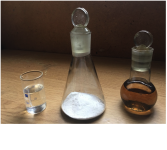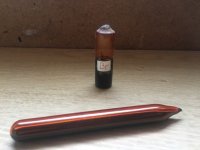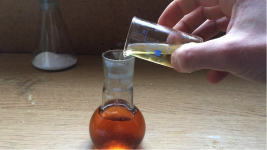Marvin "Popcorn" Sutton
Expert
- Joined
- Jul 25, 2021
- Messages
- 208
- Reaction score
- 311
- Points
- 63
Bromine is an important element and is involved in many syntheses. In some countries, the sale of bromine is controlled, and it is problematic and risky to buy it. In this article, we will look at options for obtaining elemental bromine from its compounds.
BROMINE (Bromum, Br) - element of group 17 (VIIa) of the periodic system, atomic number 35, relative atomic mass 79,904. Natural bromine consists of two stable isotopes: 79Br (50,69 at.%) and 81Br (49,31 at.%), altogether 28 isotopes with mass numbers from 67 to 94 are known. In chemical compounds bromine exhibits oxidation states from -1 to +7, in nature it is found only in the oxidation state -1.
Bromine is the only non-metal liquid at room temperature. Elemental bromine is a heavy reddish brown smelly liquid (density at 20°C - 3.1 g/cm3, boiling point +59.82°C), bromine vapour has yellow-brown colour. At temperature of -7.25°C, bromine solidifies, turning into red-brown needle-like crystals with weak metallic shine, which have the appearance of crystal iodine.
Bromine is well soluble in alcohol, ether, hydrocarbons, chloroform and other organic solvents. Bromine is much less soluble in water (3.5% at 20°С). Bromine is slightly better soluble in hydrochloric and bromine-hydrogen acids, in KBr solutions.
Aqueous bromine solution has yellow colour and is called "bromine water". Bromine water has rather strong oxidizing properties. Interestingly, saturated bromine solution in water does not solidify even at minus 20 °C.
In the solid, liquid and gaseous state bromine exists in the form of two-chatomic molecules Br2, noticeable dissociation into atoms begins only at 800 °C, dissociation occurs under the influence of light. Elemental bromine is a strong oxidising agent, it reacts directly with almost all nonmetals (except for inert gases, oxygen, nitrogen and carbon) and many metals, these reactions are often accompanied by inflammation (e.g., with phosphorus, antimony, tin).
All industrial methods of obtaining bromine from salt solutions are based on its displacement with chlorine from bromides:
In the laboratory bromine can be obtained by interaction of bromides with a suitable oxidizer in an acidic medium. The most available bromine compounds are potassium and sodium bromides. Hydrogen peroxide, potassium permanganate, bromate, potassium bichromate, manganese dioxide, hypochlorite, chlorine and other substances can be used as oxidants.
We dissolve 66 g of potassium bromide in 300 ml of water and add 18 ml of concentrated sulfuric acid. Then gradually add 17.5 g of potassium bromate in small portions. The solution turns yellow, then red. After 10 minutes, suspended drops of bromine appear in the solution and settle to the bottom. At the end of the reaction, the bromine layer can be separated with a pipette. The yield is approximately 16 ml.
An obvious disadvantage of the above method is the use of potassium bromate, which does not belong to readily available substances.
Below is another method of bromine production, as simplified as possible.
25 g of sodium bromide NaBr (about 12 ml by volume) was poured into 45 ml of 80% sulfuric acid (the bromide was not dissolved). The liquid turned white.
(Originally, we were going to add concentrated sulfuric acid to a 40-45% sodium bromide solution, but decided to simplify the procedure as much as possible).
Then 15 ml of perhydrol (<30% H2O2) was added. The mixture was stirred gently. When visibly heated, stirring was stopped to prevent the bromine from boiling; the mixture was cooled by lowering it into cold water. The bromine accumulated at the bottom, with salt crystals floating over it. When all the salt had dissolved, the mixture was left for another 5 minutes. The mixture could then be cooled to 0-5°C to reduce the solubility of the bromine in the water.
6 ml of bromine was obtained (about 18 g, yield about 90%).
The bromine can be separated in a separating funnel or with a pipette. The resulting substance can additionally be dried with concentrated sulphuric acid and distilled.
A glass jar is sufficient for the reaction, it is convenient to fix a plastic foil on it with a rubber band and, having made a hole, pour in the perhydrol and stir with a stick through it.
Even pouring over bromine water sometimes produces a caustic brown cloud. Try to pour directly under the water layer.
Bromine is almost insoluble in water and is already quite dry immediately after receiving it.

















_____________________________
Comments:
Different sources give slightly different values for the physico-chemical constants of bromine, which is apparently due to the different purity of the substance.
The use of chlorine and its compounds is undesirable because chlorine will contaminate the product.
Battery electrolyte, evaporated to white vapour, can be used.
If exactly dry bromine is required (in syntheses where water is totally unacceptable), the bromine is dried by washing with concentrated sulphuric acid.
The residual bromine from the water can be extracted with a suitable (non-reactive with bromine and non-miscible with water) organic solvent.
Aqueous drains containing dissolved bromine can be neutralised with a solution of sodium thiosulphate or sodium sulphite.
Bromine should preferably be stored in sealed vials or flasks, otherwise bromine vapour problems may occur. Storage of bromine at home is strongly discouraged.
BROMINE (Bromum, Br) - element of group 17 (VIIa) of the periodic system, atomic number 35, relative atomic mass 79,904. Natural bromine consists of two stable isotopes: 79Br (50,69 at.%) and 81Br (49,31 at.%), altogether 28 isotopes with mass numbers from 67 to 94 are known. In chemical compounds bromine exhibits oxidation states from -1 to +7, in nature it is found only in the oxidation state -1.
Bromine is the only non-metal liquid at room temperature. Elemental bromine is a heavy reddish brown smelly liquid (density at 20°C - 3.1 g/cm3, boiling point +59.82°C), bromine vapour has yellow-brown colour. At temperature of -7.25°C, bromine solidifies, turning into red-brown needle-like crystals with weak metallic shine, which have the appearance of crystal iodine.
Bromine is well soluble in alcohol, ether, hydrocarbons, chloroform and other organic solvents. Bromine is much less soluble in water (3.5% at 20°С). Bromine is slightly better soluble in hydrochloric and bromine-hydrogen acids, in KBr solutions.
Aqueous bromine solution has yellow colour and is called "bromine water". Bromine water has rather strong oxidizing properties. Interestingly, saturated bromine solution in water does not solidify even at minus 20 °C.
In the solid, liquid and gaseous state bromine exists in the form of two-chatomic molecules Br2, noticeable dissociation into atoms begins only at 800 °C, dissociation occurs under the influence of light. Elemental bromine is a strong oxidising agent, it reacts directly with almost all nonmetals (except for inert gases, oxygen, nitrogen and carbon) and many metals, these reactions are often accompanied by inflammation (e.g., with phosphorus, antimony, tin).
All industrial methods of obtaining bromine from salt solutions are based on its displacement with chlorine from bromides:
MgBr2 + Cl2 = MgCl2 + Br2.
In the laboratory bromine can be obtained by interaction of bromides with a suitable oxidizer in an acidic medium. The most available bromine compounds are potassium and sodium bromides. Hydrogen peroxide, potassium permanganate, bromate, potassium bichromate, manganese dioxide, hypochlorite, chlorine and other substances can be used as oxidants.
MnO2 + 2H2SO4 + 2NaBr = Br2 + MnSO4 + Na2SO4
To extract bromine from the resulting mixture of sodium bromide and sodium bromate, it is acidified with sulphuric acid:5NaBr + NaBrO3 + 3H2SO4 = 3Na2SO4 + 3Br2 + 3H2O
We dissolve 66 g of potassium bromide in 300 ml of water and add 18 ml of concentrated sulfuric acid. Then gradually add 17.5 g of potassium bromate in small portions. The solution turns yellow, then red. After 10 minutes, suspended drops of bromine appear in the solution and settle to the bottom. At the end of the reaction, the bromine layer can be separated with a pipette. The yield is approximately 16 ml.
KBrO3 + 5KBr + 3H2SO4 = 3Br2 + 3H2O + 3K2SO4
An obvious disadvantage of the above method is the use of potassium bromate, which does not belong to readily available substances.
Below is another method of bromine production, as simplified as possible.
25 g of sodium bromide NaBr (about 12 ml by volume) was poured into 45 ml of 80% sulfuric acid (the bromide was not dissolved). The liquid turned white.
(Originally, we were going to add concentrated sulfuric acid to a 40-45% sodium bromide solution, but decided to simplify the procedure as much as possible).
Then 15 ml of perhydrol (<30% H2O2) was added. The mixture was stirred gently. When visibly heated, stirring was stopped to prevent the bromine from boiling; the mixture was cooled by lowering it into cold water. The bromine accumulated at the bottom, with salt crystals floating over it. When all the salt had dissolved, the mixture was left for another 5 minutes. The mixture could then be cooled to 0-5°C to reduce the solubility of the bromine in the water.
6 ml of bromine was obtained (about 18 g, yield about 90%).
2NaBr + H2SO4 + H2O2 → Br2 + Na2SO4 + 2H2O
The bromine can be separated in a separating funnel or with a pipette. The resulting substance can additionally be dried with concentrated sulphuric acid and distilled.
A glass jar is sufficient for the reaction, it is convenient to fix a plastic foil on it with a rubber band and, having made a hole, pour in the perhydrol and stir with a stick through it.
Even pouring over bromine water sometimes produces a caustic brown cloud. Try to pour directly under the water layer.
Bromine is almost insoluble in water and is already quite dry immediately after receiving it.
Comments:
Different sources give slightly different values for the physico-chemical constants of bromine, which is apparently due to the different purity of the substance.
The use of chlorine and its compounds is undesirable because chlorine will contaminate the product.
Battery electrolyte, evaporated to white vapour, can be used.
If exactly dry bromine is required (in syntheses where water is totally unacceptable), the bromine is dried by washing with concentrated sulphuric acid.
The residual bromine from the water can be extracted with a suitable (non-reactive with bromine and non-miscible with water) organic solvent.
Aqueous drains containing dissolved bromine can be neutralised with a solution of sodium thiosulphate or sodium sulphite.
Safety precautions
Bromine vapour has a pungent smell, is poisonous and highly irritating to the respiratory tract. Skin contact with bromine causes sores. Bromine should be handled under drafts, using protective goggles and gloves.Bromine should preferably be stored in sealed vials or flasks, otherwise bromine vapour problems may occur. Storage of bromine at home is strongly discouraged.
Attachments
Last edited by a moderator:



